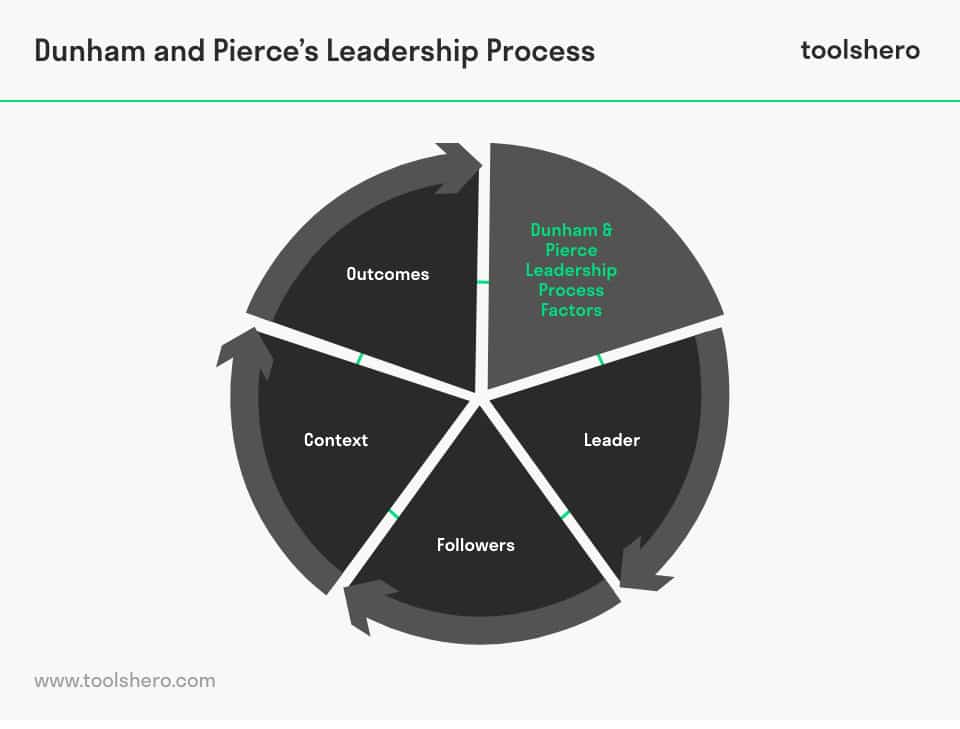Dunham and Pierce’s Leadership Process Model

Dunham and Pierce’s Leadership Process Model: this article contains a practical explanation of Dunham and Pierce’s Leadership Process Model. After reading, you will understand the basic concepts of this model and the importance of all the factors that are linked to good leadership.
What is the Dunham and Pierce’s Leadership Process Model?
Before going deeper into this model, it is important to remember that leadership is provided by one person on the team. In many cases, this person has a defined role as: director, project manager, vice president, among other names that give him or her the power to lead because of his or her position in the area of the company or project he or she is working on, but the factors that make up the leadership atmosphere are essential for success.
According to Randall B. Dunham and Jon Pierce there are four essential elements that make up the leadership process: the leader, the followers, the context and the results.
These four factors are essential to the leadership process because they connect the good performance that must be generated to achieve success. Each element is necessary for this and to achieve what you want in your field of work because each element is connected to each other. The idea is to be able to have positive thinking and actions during your leadership process.
Elements of the Dunham and Pierce Leadership Process Model
1. The leader
The person who has the responsibility and who is in charge of leading and guiding the team.
2. The followers
The people who follow the instructions of the leader and who have a specific role imposed by the leader, with the role performing the tasks that are needed for the project on which they are working.
3. Context
This is the environment where the project is generated. The work spaces, the challenges that the project presents, the organisation, the resources, etc.
4. Results
These are the results of the process. The results are the achievements of the objectives that were established in the project, the resolution of problems among others. It is also the positive result of the trust that is created in the process between the leader and the members (followers).
Dunham and Pierce’s Leadership Process Model is about the importance of the leader being able to identify the importance of his or her followers and the context in which they are located in order to achieve the desired outcomes.
It is common for the leader’s decisions or actions to affect the team for better or worse, but it should also be noted that the actions of followers can also generate certain feelings or situations on the part of the leader. You must identify what your team looks like and how these actions can lead to success if they are understood and addressed appropriately in the necessary context.
This is how the leader, the followers and the context are connected to affect the results. These results will be fed back to impact those involved. The Leadership Process is a learning process that advances as you work in a group.
Leadership is a continuous process that is active and dynamic. It is important to have a good relationship with your followers in order to obtain the desired successful results. You can affect them or they can affect you in a positive or negative way, but that is where knowing how to identify and process the actions you have in the team and take advantage of them.
How to apply this model in your company?
There are several key points of this model to improve leadership processes.
Giving feedback
It is important that one constantly gives feedback to their team so that they know how the project processes are going. What needs to be improved or if everything is in order.
When giving feedback to the team this can include motivation towards achieving results, giving honest feedback, correcting or guiding is valued in teamwork. Your team is likely to meet objectives and you will also learn about the good use of feedback.
It is important to give feedback as the objectives or SMART Goals are met.
Focusing on actions and reactions
This model emphasizes that your actions, decisions and behaviour can directly affect your followers. Every action you take will have a reaction on them or on the process.
As a leader you must express what you think and also perform actions that will not always be well seen by your followers. These reactions may not appear immediately, but can appear later and affect the team negatively such as poor performance, low motivation etc.
It is important to control your emotions at work and be a good role model when making decisions or taking actions that may affect your employees – followers.
Lead ethically and honestly
The Dunham and Pierce’s Leadership Process Model also shows the relationship between leaders and followers. If the relationship between the leader and his or her followers is based on trust and respect, the context of the results will be positive. However, if the relationship is based on fear and low motivation, the context of the results will be negative.
Trust will lead to good results and success. It is important to be a leader with whom you can talk without fear or mistrust, hence the importance of ethics at work and in your leadership role.
If your team trusts you, you will have no problem with them not following your instructions and decisions. They will follow you with confidence and conviction and will do their best to achieve good results for the company.
Lead with the right style
It is important to choose a type of leadership, the most used and with the best results, is transformational leadership. Leaders with this type of leadership have integrity, clear and SMART goals and good communication with the team.
Transformational leadership proposes an exchange between the leader and his or her followers, so that when they work they get something in return. It is a leadership style that motivates and transforms people.
From time to time you will need to adopt different leadership approaches to suit a particular follower, outcome or context. This is why it is useful to be able to use other leadership styles when appropriate as not all contexts are the same. Flexibility in adapting your role as a leader will lead you on a learning path.
Assign tasks with awareness
Assign tasks according to the skills each member of your team has. Being able to achieve good results goes hand in hand with the tasks you assign and to whom you assign them. This is also connected to the motivation and happiness with which people perform the activities when it is something that is in their experience or liking.
Focusing on relationship development
Sometimes it is thought that your team depends on you as a leader, however, the opposite is true. The importance of good relationships will make for positive results.
Managing emotional intelligence is vital to being able to guide your team in difficult circumstances. It is vital that you reward your team for good work performance, even with a thank you. A thank you will motivate your team to continue to meet objectives and achieve good results.
Dunham and Pierce’s Leadership Process Model: important points
The Dunham and Pierce’s Leadership Process Model is dynamic and helps in the long term as it shows how behaviour and decisions influence followers, and that they also influence one as a person in the workplace.
With the above explained, you can provide regular feedback, be aware of your actions and reactions, lead with good communication and ethics, lead in the style that suits you best, assign tasks consciously, focus on developing relationships.
All this linked to the good relationships you have with your team, this can influence positively or negatively on the results you want to achieve for the company.
In the long term you will see how the leadership process can bring you closer to your followers, and that they will approach you without fear, but rather with confidence to communicate the progress of the project, doubts and so on. And have more possible success in what you want to achieve as a professional, person and team.
Conclusion of the Dunham and Pierce’s Leadership Process Model
The Dunham and Pierce’s Leadership Process Model is interconnected with the actions and reactions of the leader with his or her followers, and how his or her followers can affect the leader positively or negatively. With the actions his team takes these are part of the context and the results in the future. If those actions are the right ones in the right context you have a chance of successful results.
Feedback during the leadership management process is vital in order to help your followers with the roles you are playing. These assigned roles must go hand in hand with the experience and taste that your follower has and feels.
Focusing on the training and experience your followers have will not only keep them from getting bored with their responsibilities, but will also increase their motivation to perform their tasks, as they have the expertise to do what they are assigned to do.
The Dunham and Pierce’s Leadership Process Model also helps to visualize the importance of the leadership context, to empower the staff, to improve the results based on the good relationship that can be had with the team.
For all of the above, the importance of ethics when leading will give your followers confidence in their responsibilities and good communication between the team to solve problems, concerns or simply report on the progress of the project.
Leadership is not always easy but Dunham Pierce’s Leadership Process Model does a good job of highlighting the key points of the leadership process. For the leader who is trying to maintain a balance of actions and working relationships, this model can lead to potential success.
The importance of relationships with your team will always be an essential factor in this model, as the protagonist here is not just the leadership being exercised, but what your team feels in the context they are working in.
Good relationships in this leadership process are essential to achieve success in the projects you have as a company. Relationship, listening and good communication are part of this whole leadership process in which you always want a good balance between the actions and reactions of your employees.
It is your turn
What do you think? Have you implemented Dunham and Pierce’s Leadership Process Model? Do you think good relationships bring good actions and reactions in a team? If so, tell us about your experience? Does a leader who has a positive mind bring positive actions? Do you have any suggestions or anything else to add?
Share your experience and knowledge in the comments box below.
More information
- Dunham, R. B., & Pierce, J. L. (1989). Managing. Leadership Process Model. Taking an Intelligent, Long-Term Approach to Leadership.
- Dunham, R. B., & Pierce, J. L. (1987). Organizational commitment: Pre-employment propensity and initial work experiences. Journal of management, 13(1), 163-178.
- Gardner, D. G., Cummings, L. L., Dunham, R. B., & Pierce, J. L. (1998). Single-item versus multiple-item measurement scales: An empirical comparison. Educational and psychological measurement, 58(6), 898-915.
- George, J. M., & Jones, G. R. (2001). Towards a process model of individual change in organizations. Human relations, 54(4), 419-444
How to cite this article:
Ospina Avendano, D. (2020). Dunham and Pierce’s Leadership Process Model. Retrieved [insert date] from toolshero: https://www.toolshero.com/leadership/dunham-and-pierces-leadership-process-model/
Add a link to this page on your website:
<a href=”https://www.toolshero.com/leadership/dunham-and-pierces-leadership-process-model/”>toolshero: Dunham and Pierce’s Leadership Process Model</a>
Published on: 02/12/2019 | Last update: 16/02/2022













